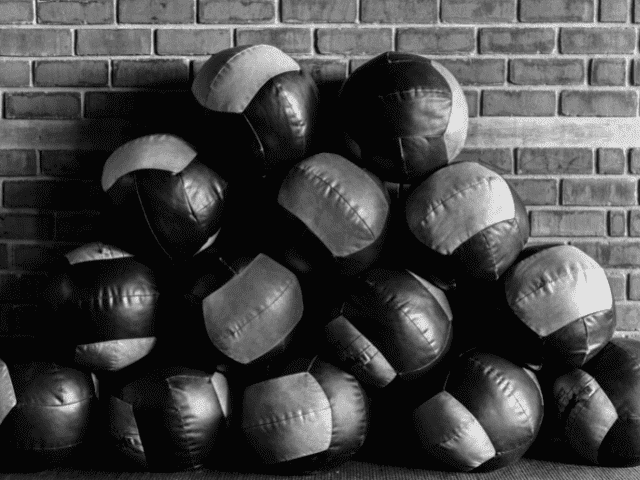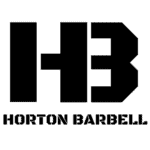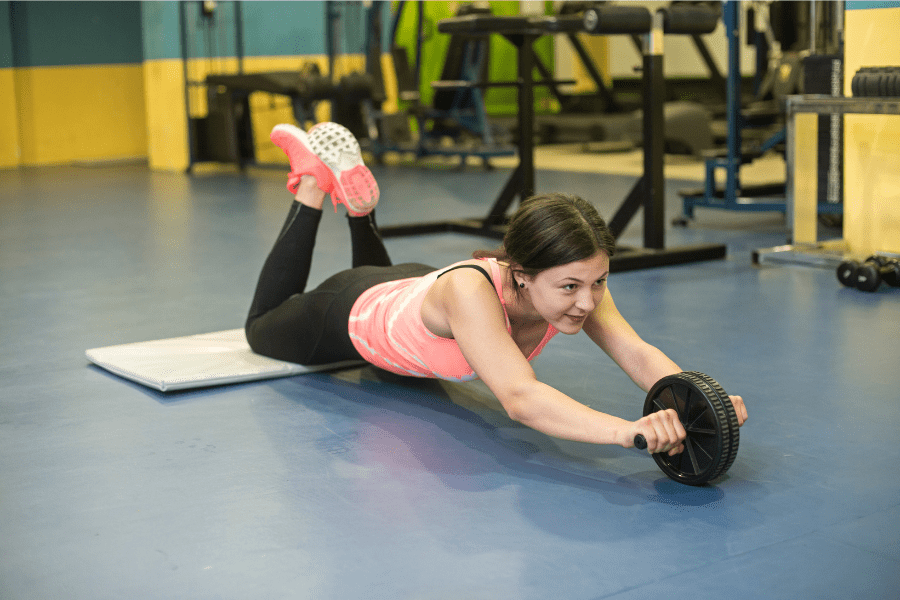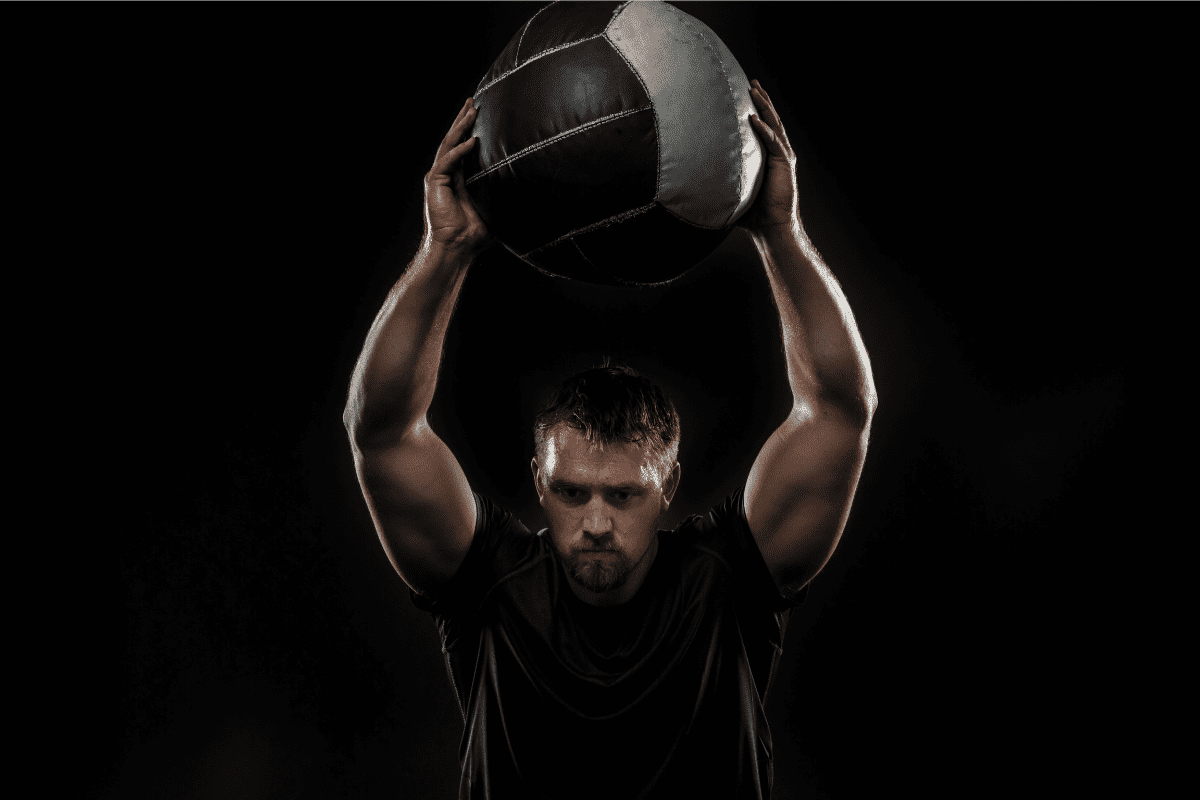10 Medicine Ball Slam Alternatives For a Powerful Core
Medicine Ball Slams are one of the most effective exercises for building a powerful core. They’re also very beginner-friendly and can fit nicely into a warm-up.
However, sometimes you may find yourself needing an alternative for Med Ball Slams.
Maybe you don’t have a medicine ball or maybe you’re just looking to add some variety to your workouts.
Whatever the reason, if you’re looking for an exercise to substitute for Medicine Ball Slams then you’re in the right place. I’m about to share with you 10 of my favorite Med Ball Slam alternatives including a few different variations and lifts using different equipment.
Alternatives for Medicine Ball Slams
The first few alternatives listed here are other medicine ball exercises that also target the abdominals. These can all add some variety to your med ball work.
The next few alternatives are exercises that try to mimic the same movement pattern and functionality of Med Ball Slams but are done with different pieces of equipment. These are all good options if what you’re lacking is a medicine ball.
The last few movements are dynamic core movements. They don’t necessarily mimic Medicine Balls Slams exactly, but they are core exercises that work the core dynamically to improve not just core strength, but core power as well.
Medicine Ball Side Slams

Med Ball Side Slams are by far the closest related movement to Med Ball Slams. The difference here is by rotating to the side as you throw you’re getting the obliques much more involved.
Step-by-Step Instructions
- Grab a medicine ball and stand tall with feet roughly shoulder-width apart.
- Reach the medicine ball high overhead.
- Using the core, pull the body down – hinging forward at the hips – while simultaneously rotating to one side.
- Follow through with the arms and release the ball. The ball should hit the ground just to the outside of the feet.
- Let the ball slam into the ground, catch it off the bounce and repeat (alternating back and forth to each side).
Coaching Points
First and foremost, test how ‘bouncy’ your medicine ball is before starting. I can’t tell you how many times I’ve seen athletes almost have their face smashed by a medicine ball bouncing much harder and rebounding much faster off the ground than they were anticipating.
The biggest mistake I see with Med Ball Side Slams is athletes not utilizing the core and simply throwing the ball down with their arms. The bulk of the force should be generated by aggressively using the core to hinge forward. If done correctly, it should almost (and actually might) lift your feet up off the floor.
Medicine Ball Situp and Throw

One of my favorite medicine ball exercises is the Medicine Ball Situp and Throw. It mimics the Med Ball Slam almost exactly. The only differences being the starting position and the direction the ball is thrown.
Step-by-Step Instructions
- Find a partner (or wall) and sit down an appropriate distance away*.
- Lay on your back holding the medicine ball overhead on the ground.
- Brace the core, engage the lats, aggressively begin to raise off the ground and throw the ball as hard as possible for distance.
- The follow-through of the throw should bring you to a full situp position.
- Allow your partner to throw the ball back (or retrieve the ball coming back from the wall) and repeat.
Coaching Points
*The distance away from your partner should be far enough that the ball will hit the ground before reaching your partner so they do not have to catch the ball out of the air. If using a wall, the distance away will be dependent upon the amount of bounce the ball gets off the wall. Find a distance so that you do not need to move between reps.
The biggest mistake I see with athletes trying to learn Situp and Throws involves the timing of the movement. The throw should initiate the situp, not the other way around. If you try to situp first, the movement will turn into more of a situp followed by a chest pass – not the intention of the movement.
I cue my athletes to just concentrate on the throw. If they throw the ball hard enough the situp will happen naturally.
Sledgehammer Slams

Sledgehammer Slams may look a lot different than Medicine Ball Slams, but the muscles used and the overall movement pattern is actually very similar. If you have access to a Sledgehammer and a Tractor Tire, they can work as an excellent alternative for Med Ball Slams.
Step-by-Step Instruction
- Hold the sledgehammer with one hand on the end of the handle and the other hand about 3/4 of the way toward the head of the hammer.
- Take a strong athletic stance. Slight bend in the knee and hips back.
- Always remember to engage the core.
- Pull the hammer up and rotate the hammer until it is slightly overhead.
- Your arms should still be slightly bent.
- Forcefully bring the hammer down to slam
- As the hammer approaches the tire, you should feel your top hand slide and they will be together at impact.
Coaching Points
Be sure to select a hammer that is not too heavy. If the hammer is too heavy, you will not have proper form and you will not benefit from the exercise
Focus on force production. Slam the tire as hard as you can!
Remember to engage the core. As you bring the hammer down, really pull down with those lats and abs to get the best strike possible.
Battle Rope Slams

Like Sledgehammer Slams, Battle Rope Slams also mimic the same movement pattern and muscles worked as Med Ball Slams. If you have access to a Battle Rope they can make an excellent Medicine Ball Slam Alternative.
Step-by-Step Instructions
- Wrap your battle rope around a solid, stable object. (A squat rack is often a good option)
- Extend the rope, removing the majority (but not all) of the slack out of the rope.
- Grab the two ends of the rope, one in each hand.
- Assume a good athletic position – knees bent, hips bent, flat back, core braced.
- Raise the ends of the rope above the head and then aggressively ‘slam’ them back towards the ground.
- This should create a ripple effect in the rope.
- Continue raising and slamming the rope in rhythm until all reps are completed.
Coaching Points
One of the keys to Battle Rope Slams is experimenting to find the optimal amount of slack to leave in the rope. You want enough slack that it doesn’t hinder the full range of motion, but not too much slack that it’s hard to develop a rhythm with the rope.
Make sure whatever you’re using as an anchor for the battle rope is secure. Battle rope movements generate a lot of power and momentum and can come loose easily if not secured in place.

Tired of coming up with your own workouts? But don’t want to pay an arm and a leg?
I post workouts 5 days a week right here. (Did I mention they’re free?)
Cable Crunches

Cable Crunches aren’t nearly as dynamic as some of the other exercises listed, but they are a similar movement that is an effective core exercise.
Step-by-Step Instructions
- Set up a cable machine at a height where the attachment can reach close to the floor.
- Grab the attachment*, pull it to the back of the shoulders (similar to a back squat) and sit down on your knees.
- Start with the torso completely upright.
- Then, crunch down, taking your shoulders down towards your thighs.
- Slowly return back to the starting position and repeat.
Coaching Points
*The two most popular attachment to use for Cable Crunches is the rope and the long straight bar. I would suggest trying both and seeing which you like better.
You don’t need to go super heavy with Cable Crunches. Instead, keep tension on the core throughout the movement and focus on the contraction of each rep. The time under tension over the course of the set will accumulate and you’ll really notice the burn towards the tail end of the set.
Pro Tip: If you don’t have a cable machine, you can do the exact same exercise with a resistance band. Simply loop a resistance band around the top of the squat rack and do the exact same movement with the band.
Weighted Situps

Sometimes the simplest solution is often the best. When in doubt, you can always substitute Weighted Situps for Medicine Ball Slams. Keep the weight light and focus on the speed of the movement.
Step-by-Step Instructions
- Grab a plate or dumbbell, lay on your back, knees bent, feet flat on the floor.
- Hold the weight tight against the chest if possible.
- Sit up by contracting and flexing the abdominals.
- Lower back down to the floor and repeat.
Coaching Points
The biggest mistake I see with Weighted Sit-Ups is holding the weight too low, down towards the stomach. Holding the weight too low takes away much (if not all) of the added resistance that the weight is supposed to be providing.
Ab Wheel

The Ab Wheel uses a similar movement pattern and can be done with dynamic effort to develop power in addition to strength. If you don’t have an Ab Wheel you can also use a barbell with bumper plates on each side.
Step-by-Step Instructions
- Start on your knees with hands on the ab wheel handles.
- Brace the core and begin pushing the wheel forward along the ground.
- Keep rolling out, extending the body until it feels like you’re going to lose tension and fall.
- Stop just short of losing your tension and pull the wheel back towards you.
Coaching Points
Make sure to keep the core braced so the strain doesn’t end up in the low back. As your core becomes stronger you’ll be able to extend out further with the wheel.
Suitcase Crunches

Suitcase Crunches are the only Med Ball Slam alternative listed here that requires zero equipment. If you’re limited on equipment they can be a great option.
Step-by-Step Instructions
- Start by sitting on the ground, balancing on your butt with legs and back up off the ground.
- Legs should be almost straight, feet roughly six inches off the ground. Torso should be leaned back at about a 30 degree angle.
- From the starting position, crunch up, bringing the knees and chest together above the hips (like a suitcase shutting)
- Lower back to the starting position and repeat until all reps are completed. (Feet and back should stay off the ground throughout the movement)
Coaching Points
If you keep your feet uncrossed during the movement, your groin will be forced to stay engaged. This creates a small added bonus to the exercise.
Knees to Elbows
Knees to Elbows are a dynamic hanging ab movement. Not only will they help build a powerful core, but they’ll also work the back, biceps and forearms as well.
Step-by-Step Instructions
- Find yourself a pull-up bar and grip the bar with an overhand grip
- Engage your lats so your body doesn’t go limp once you begin to hang
- Now hang from the bar and flex your arms to about a 90-degree angle at the elbow
- Lift the knees up and slightly roll the hips forward until the knees touch the elbows
- Actively drive your legs down and straight and then repeat.
- Don’t allow your legs to ‘just fall’ after touching your knees or you’ll swing uncontrollably.
Coaching Points
The biggest issue that most of my athletes run into when doing Knees To Elbows is how to keep from swinging.
To keep from swinging, you have to actively lower your legs back down. If you ‘let your legs go’ and just allow gravity to take over you’ll completely lose control of the movement. Timing and rhythm are both important for Knees To Elbows and you can’t achieve either if you’re not in control of your legs throughout the movement.
Toes to Bar
Toes to Bar are an even more advanced version of Knees to Elbows. If you’re looking for an exercise that can help you develop an extremely powerful core, look on further than Toes to Bar.
Step-by-Step Instructions
- Find yourself a pull-up bar and grip the bar with an overhand grip
- Engage your lats so your body doesn’t go limp once you begin to hang
- Now hang from the bar with a slight flex at the elbow
- Keeping the legs straight, flex the core and lift the legs up until your toes touch the pull-up bar.
- Lower the legs under control to help keep them from swinging uncontrollably.
Coaching Points
The biggest issue that most of my athletes run into when doing Toes to Bar is how to keep from swinging, or better yet, how to properly utilize that swing as a positive and not a negative.
To keep from swinging, you have to actively lower your legs back down. If you ‘let your legs go’ and just allow gravity to take over you’ll completely lose control of the movement.
Timing and rhythm are both important for Toes to Bar and you can’t achieve either if you’re not in control of your legs throughout the movement.

Get Shredded… For Free
Get a free workout Monday through Friday, posted right here on Horton Barbell. These workouts are designed to help you get strong, in shape and look great at the beach!
Final Thoughts
Medicine Ball Slams are an excellent exercise for developing a strong, powerful core but sometimes Med Ball Slams just aren’t an option. You may not have the proper equipment available to you or at other times you might just be looking to add some variety to your training program.
In these situations, you’ll need a Med Ball Slam alternative and I hope that at least one of the exercises I’ve listed here fits what you were looking for.

